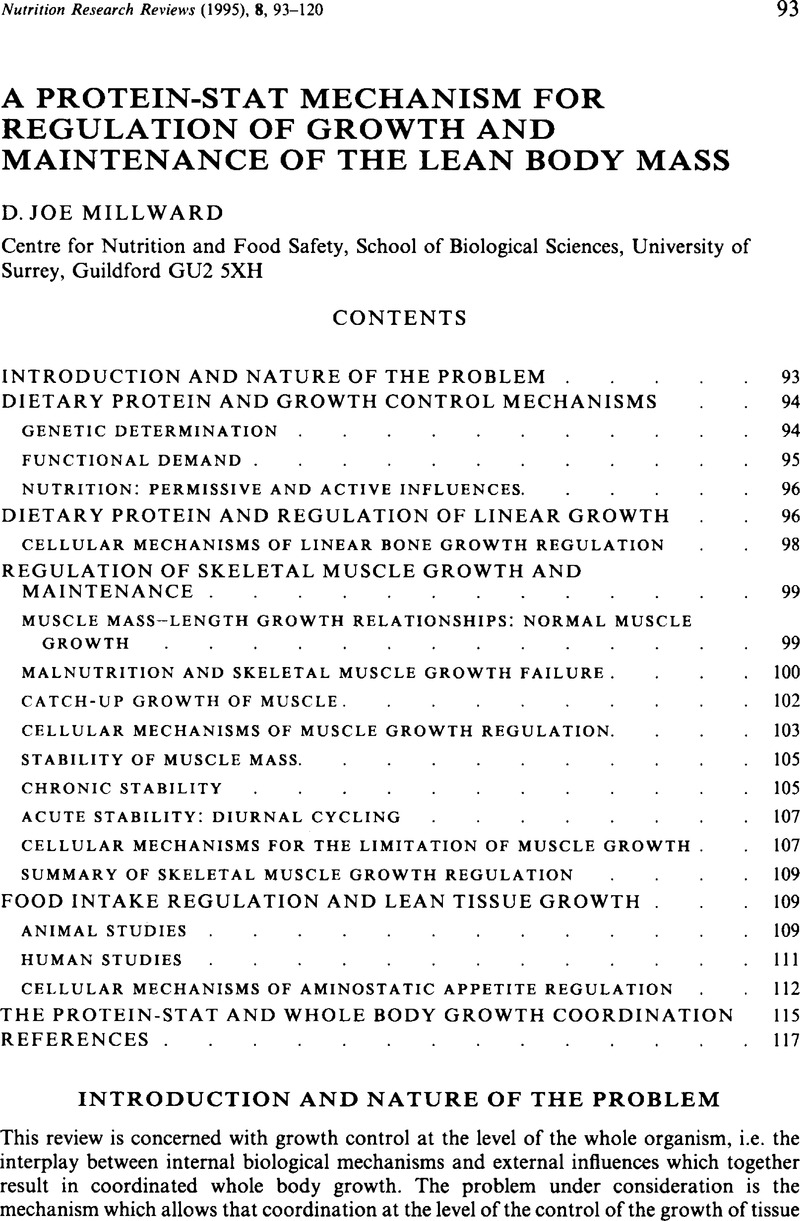Crossref Citations
This article has been cited by the following publications. This list is generated based on data provided by Crossref.
Millward, D. Joe
and
Roberts, Susan B.
1996.
Protein Requirements of Older Individuals.
Nutrition Research Reviews,
Vol. 9,
Issue. 1,
p.
67.
Griffiths, Richard D.
1996.
Muscle mass, survival, and the elderly ICU patient.
Nutrition,
Vol. 12,
Issue. 6,
p.
456.
Oldham, John D.
Emmans, Gerry C.
and
Kyriazakis, Ilias
1997.
Limits and limitations to nitrogen use in farm animals.
Proceedings of the Nutrition Society,
Vol. 56,
Issue. 2,
p.
525.
Schadereit, R.
Klein, M.
Souffrant, W.‐B.
Krawielitzki, K.
and
Renne, U.
1997.
Protein metabolism in mice selected for high carcass protein content or high body weight.
Journal of Animal Physiology and Animal Nutrition,
Vol. 78,
Issue. 1-5,
p.
105.
Dulloo, A. G.
1997.
Human pattern of food intake and fuel-partitioning during weight recovery after starvation: A theory of autoregulation of body composition.
Proceedings of the Nutrition Society,
Vol. 56,
Issue. 1A,
p.
25.
Millward, D. Joe
and
Wijesinghe, D. G. N. G.
1998.
Energy partitioning and the regulation of body weight – Reply by Millward & Wijesinghe.
British Journal of Nutrition,
Vol. 79,
Issue. 1,
p.
111.
Cadogan, Joanna
Blumsohn, Aubrey
Barker, Margo E.
and
Eastell, Richard
1998.
A Longitudinal Study of Bone Gain in Pubertal Girls: Anthropometric and Biochemical Correlates.
Journal of Bone and Mineral Research,
Vol. 13,
Issue. 10,
p.
1602.
Millward, D. Joe
1998.
Metabolic Demands for Amino Acids and the Human Dietary Requirement: Revisited.
The Journal of Nutrition,
Vol. 128,
Issue. 12,
p.
S2563.
Forslund, Anders H.
Hambraeus, Leif
Olsson, Roger M.
El-Khoury, Antoine E.
Yu, Yong-Ming
and
Young, Vernon R.
1998.
The 24-h whole body leucine and urea kinetics at normal and high protein intakes with exercise in healthy adults.
American Journal of Physiology-Endocrinology and Metabolism,
Vol. 275,
Issue. 2,
p.
E310.
Millward, D. Joe
1999.
Optimal intakes of protein in the human diet.
Proceedings of the Nutrition Society,
Vol. 58,
Issue. 2,
p.
403.
Waterlow, J. C
1999.
The mysteries of nitrogen balance.
Nutrition Research Reviews,
Vol. 12,
Issue. 1,
p.
25.
Forslund, Anders H.
El-Khoury, Antoine E.
Olsson, Roger M.
Sjödin, Anders M.
Hambraeus, Leif
and
Young, Vernon R.
1999.
Effect of protein intake and physical activity on 24-h pattern and rate of macronutrient utilization.
American Journal of Physiology-Endocrinology and Metabolism,
Vol. 276,
Issue. 5,
p.
E964.
Clark, Joseph F
and
Kranc, Kamil R
1999.
The role of the mitochondrion in smooth muscle cell fate choices of proliferation versus apoptosis during vascular and cardiovascular diseases.
Emerging Therapeutic Targets,
Vol. 3,
Issue. 4,
p.
513.
Stubbs, R.James
1999.
Peripheral signals affecting food intake.
Nutrition,
Vol. 15,
Issue. 7-8,
p.
614.
Badaloo, Asha
Boyne, Michael
Reid, Marvin
Persaud, Chandarika
Forrester, Terrence
Millward, D. Joe
and
Jackson, Alan A.
1999.
Dietary Protein, Growth and Urea Kinetics in Severely Malnourished Children and During Recovery.
The Journal of Nutrition,
Vol. 129,
Issue. 5,
p.
969.
Russell, K.
Lobley, G. E.
Rawlings, J.
Millward, J.
and
Harper, E. J.
2000.
Urea kinetics of a carnivore,Felis silvestris catus.
British Journal of Nutrition,
Vol. 84,
Issue. 5,
p.
597.
Long, S.J.
Jeffcoat, A.R.
and
Millward, D.J.
2000.
Effect of habitual dietary-protein intake on appetite and satiety.
Appetite,
Vol. 35,
Issue. 1,
p.
79.
Forbes, J. M.
2001.
Editorial.
Nutrition Research Reviews,
Vol. 14,
Issue. 1,
p.
1.
Bohé, Julien
Low, J. F. Aili
Wolfe, Robert R.
and
Rennie, Michael J.
2001.
Rapid Report.
The Journal of Physiology,
Vol. 532,
Issue. 2,
p.
575.
Russell, K.
Lobley, G. E.
and
Millward, D. J.
2003.
Whole-body protein turnover of a carnivore,Felis silvestris catus.
British Journal of Nutrition,
Vol. 89,
Issue. 1,
p.
29.



